Kenneth Branagh’s Thor takes the Marvel comic hero to the mythic realms of Asgard, Midgard (Earth), and Jotunheim, all inside a cosmic tree known as Yggdrasil. We talk to visual effects supervisor Wesley Sewell and some of the VFX vendors about a few key sequences from the film.
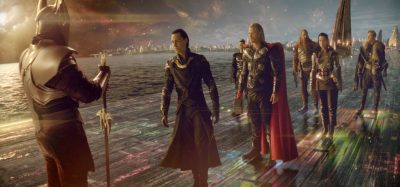 The film tells the story of Thor, son of Odin, who is banished from Asgard by his father to Midgard and must deal with an unlikely existence on the strange planet, as well as the evil intentions of his brother Loki. Visual effects supervisor Wesley Sewell looked to the film’s various realms to split the work among vendors – Whiskytree handled views of the city of Asgard while BUF completed the rainbow bridges and Heimdall’s observatory effects; Digital Domain created Jotunheim, the Frost Giants and Frost Beast; and Luma Pictures delivered the Destroyer sequences and various shots on Midgard. Fuel VFX, Evil Eye Pictures and an in-house team of compositors rounded out the visual effects contribution, while The Third Floor handled previs and Legacy Effects created various Frost Giant suits, make-up effects and macquettes.
The film tells the story of Thor, son of Odin, who is banished from Asgard by his father to Midgard and must deal with an unlikely existence on the strange planet, as well as the evil intentions of his brother Loki. Visual effects supervisor Wesley Sewell looked to the film’s various realms to split the work among vendors – Whiskytree handled views of the city of Asgard while BUF completed the rainbow bridges and Heimdall’s observatory effects; Digital Domain created Jotunheim, the Frost Giants and Frost Beast; and Luma Pictures delivered the Destroyer sequences and various shots on Midgard. Fuel VFX, Evil Eye Pictures and an in-house team of compositors rounded out the visual effects contribution, while The Third Floor handled previs and Legacy Effects created various Frost Giant suits, make-up effects and macquettes.
The look and feel of Thor, and appropriately its visual effects, came directly from the director’s wish that the film play out as classic science-fiction, rather than fantasy. “It was a very exciting moment when Ken brought that up,” recalls Sewell. “Suddenly all the tonality of the film made sense. The comic books are a bit fantastical, but we had to treat it like Asgard is really a place and all the other realms are really places. We had these magical concepts we had to consider and we didn’t want to go down too much of a Lord of the Rings feel. It was a comic superhero who was a Norsk God. When you play it that he’s an extra-terrestrial, it’s a really fun concept and the effects are built to support that.”
Drawing inspiration from the original comic book material, Marvel artists and a previs team from The Third Floor assisted in the conceptual effort, which continued through principal photography to post-vis. “We also did a lot of what we called tech-vis,” says Sewell. “Once we had a sequence we knew we would be shooting, we’d get the dimensions of the stage and put that into Maya where they were working. We would now look at that camera on that lens on that stage and we’d know where the greenscreens should be. Also, the design team was working in 3D and we could swap models and bring them into previs.”
In the realm of Frost Giants – Jotunheim’s icy world
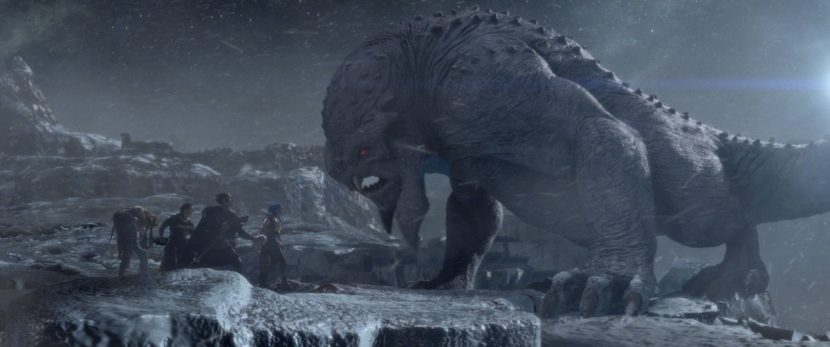 An early realm shown in the film is the world of Jotunheim, home of the Jotuns, or Frost Giants. In a past war with the Asgardians, the Frost Giants lost the source of their power and are now a depleted race on a ruined planet, but are visited by Thor and his friends in a daring moment of brashness. “On Jotunheim, the color palette was dramatically reduced,” says Sewell. “The look is an icy ode to the fine art of Caspar David Friedrich with the comic book flair of Oliver Coipel. Every effort was made to have each shot framed as a graphic novelist would but with the moving aesthetic of cinema.” Environments and computer generated characters for the battle against the Frost Giants and the Frost Beast were created by Digital Domain under visual effects supervisor Kelly Port.
An early realm shown in the film is the world of Jotunheim, home of the Jotuns, or Frost Giants. In a past war with the Asgardians, the Frost Giants lost the source of their power and are now a depleted race on a ruined planet, but are visited by Thor and his friends in a daring moment of brashness. “On Jotunheim, the color palette was dramatically reduced,” says Sewell. “The look is an icy ode to the fine art of Caspar David Friedrich with the comic book flair of Oliver Coipel. Every effort was made to have each shot framed as a graphic novelist would but with the moving aesthetic of cinema.” Environments and computer generated characters for the battle against the Frost Giants and the Frost Beast were created by Digital Domain under visual effects supervisor Kelly Port.
– See Mike Seymour’s in-depth podcast with Digital Domain visual effects supervisor Kelly Port about the creation of Jotunheim, the Frost Giants and the Frost Beast.
Future antiquity – crafting Asgard’s vistas
For shots of Asgard, Thor’s homeland, Whiskytree in San Francisco and visual effects supervisor Jonathan Harb approached the work – around 75 shots – with a relatively small crew of 35. Whiskytree’s brief was to make Asgard have an ancient yet futuristic feel, something Wesley Sewell had coined ‘future antiquity’. “From the outset they made it clear it was very advanced, but also very old,” notes Harb. “We had to strike that balance. There are no roads, for instance, which can be something ancient or futuristic, but it’s certainly a different society. We strove for a line that was very simple, but certainly modern and advanced but that could be perceived as timeless.”
Sewell and Harb relied on months of concept art and designs from Marvel artists and production designer Bo Welch, as well as a history of comic book art, such as that by legendary Marvel artist Jack Kirby. The teams were also able to easily share assets. “For example,” says Harb, “Odin’s Tower started as a CG model in the art department. We grabbed that model and kept working on it. We literally kept working on that and finished the last details in January this year.”
Production filmed a number of Asgard sets, some vast and others, such as the throne room and banquet hall, altered slightly and re-purposed. “One thing that was interesting,” says Harb, “was that there were all these little organic, fractal touches that were in a lot of the production design and sets that were created. There’s a very interesting tile pattern on the throne room wall. Ordinarily you’d expect a tile pattern to be something like brick, but actually each tile is the same size and the next is offset in a relationship like a seashell, so from one row to the next, the spacing gets slightly larger. So by the time you’re up the top, that next tile has shifted again further. We had to keep that approach for the wider shots too, say for Odin’s Tower.
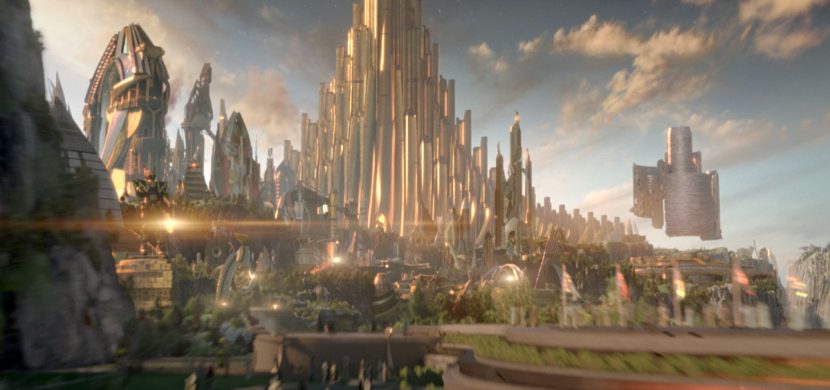 Whiskytree constructed most of the city as CG geometry, drawing on its artists’ rich experience with matte paintings, but up’ing the 3D nature of their effects for Thor like no other show they had previously worked on, both to create a sense of detail and to accommodate the stereo nature of the film. “We’d start with relatively simple dirt map or ambient occlusion renders and as soon as we got materials going, we’d gradually advanced the images we showed,” says Harb. “We used Softimage for 3D and rendered with Arnold – which was in alpha to beta while we worked on the show. We used Nuke for 2D animation and compositing.”
Whiskytree constructed most of the city as CG geometry, drawing on its artists’ rich experience with matte paintings, but up’ing the 3D nature of their effects for Thor like no other show they had previously worked on, both to create a sense of detail and to accommodate the stereo nature of the film. “We’d start with relatively simple dirt map or ambient occlusion renders and as soon as we got materials going, we’d gradually advanced the images we showed,” says Harb. “We used Softimage for 3D and rendered with Arnold – which was in alpha to beta while we worked on the show. We used Nuke for 2D animation and compositing.”
For Asgardian skies, a mixture of Earth-looking sky and views of the cosmos, Whiskytree looked to space photography for reference and completed paintings in Photoshop, often coupled with displacements for some of the mistier elements or clouds.
One significant shot is Thor’s coronation on Asgard, which combined a 60 foot throne room set and two rows of crowds on either side with digital extensions, including drapes that slightly waft in the shot. “The live action initially felt a little small,” remarks Harb, “so we took that throne room shot and put it in an enormous space inside of the tower. It meant we had these big crowd extensions, which were digital doubles with animation cycles on them. Because it’s in stereo, literally everything is geometry with textures. The banners had some subtle movement that helped frame the space and add scale.”
An exterior helicopter shot of Asgard that glides past the tall buildings and cliff shapes also became a key moment in the film for Harb, and one that was worked on from March 2010 throughout the duration of production. “In that shot we had things like little wakes on the boats in the bottom of the fjords, and part of the way through the shot there’s a garden full of plants. There were elevated waterways in the shot as well and waterfalls that start all the way up high and go down into the chasms.”
Rainbow bridges
Thor and others are able to travel between worlds on a rainbow bridge called Bifrost. That journey begins at Heimdall’s observatory on Asgard, itself connected to Odin’s palace via a solid crystalline bridge with rainbow properties across a saturnal ocean. BUF completed the visual effects for these scenes, under supervisor Nicolas Chevallier and supervising VFX art direction by Pierre Buffin.
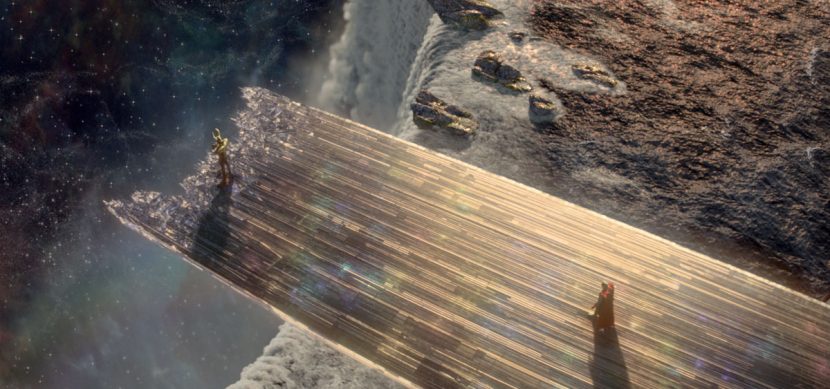 For shots of the actors on the crystalline rainbow bridge, Sewell designed platforms five feet off the ground made of one inch plexiglass that would provide a clear surface to walk on and could be under-lit. “We did some test shoots so that we could project the right colors,” says Sewell. “The plexiglass had some reflectivity to it, but it was a little too transparent, so we ended up putting Mylar sheets over the top of it to get more reflections. We also hung greenscreens in a certain way so that the reflections would also be green and we could key those.” Buf then added shimmering rainbow light to the bridge, and was responsible for the CG ocean, waterfall, observatory, its subsequent explosion, beam effects and cosmic surrounds.
For shots of the actors on the crystalline rainbow bridge, Sewell designed platforms five feet off the ground made of one inch plexiglass that would provide a clear surface to walk on and could be under-lit. “We did some test shoots so that we could project the right colors,” says Sewell. “The plexiglass had some reflectivity to it, but it was a little too transparent, so we ended up putting Mylar sheets over the top of it to get more reflections. We also hung greenscreens in a certain way so that the reflections would also be green and we could key those.” Buf then added shimmering rainbow light to the bridge, and was responsible for the CG ocean, waterfall, observatory, its subsequent explosion, beam effects and cosmic surrounds.
Buf also completed a number of the actual blasts into space emanating from the observatory and the film’s final end title sequence which travels the cosmos. “In the end title sequence,” explains Sewell, “we travel from Earth through a wormhole, past a black hole event horizon, on through a fractal increase in scale, until we behold the entire universe as a magnificent tree, a literal Yggdrasil. Then we zoom through it’s trunk and branches until we reach the top and find Asgard. Here we attempted to create a cinematic first where we ride from one destination to another across the cosmos with an exciting sense of scale, grandeur, and breathtaking beauty.”
An encounter with Destroyer
The climax of the film is a devastating encounter with the Asgardian robot-like protector The Destroyer, which has been sent to Earth by Loki to kill Thor. Envisaged as a protector of Asgard treasures, The Destroyer is a metallic robot-like war machine, capable of taking out foes with a fiery beam of energy. Luma Pictures, under visual effects supervisor Vincent Cirelli, was responsible for the enchanted suit of armour.
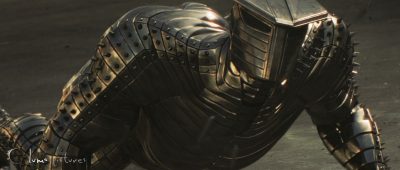 “The main challenge with The Destroyer,” says Cirelli, “is that we had a big metal suit of armour walking down the street in daylight. And he’s made up of rigid metal slats that encircle his body – a couple hundred of them. So we had to come up with some proprietary lighting techniques that allowed us to control reflections and place them where we wanted them.
“The main challenge with The Destroyer,” says Cirelli, “is that we had a big metal suit of armour walking down the street in daylight. And he’s made up of rigid metal slats that encircle his body – a couple hundred of them. So we had to come up with some proprietary lighting techniques that allowed us to control reflections and place them where we wanted them.
Although the character had to perform extreme fight motions and create general mayhem, there was a push for The Destroyer not to have any obvious bends in its metal. Luma subsequently created a complex rig that allowed artists to amortize the range of motion over many of the slats. “For example,” explains Richard Sutherland, CG Supervisor, “if he were to bend his arm normally, you would see a huge gap in the space in the elbow where the bands separate. Well, we couldn’t have The Destroyer with a bunch of holes in him. So the rig would calculate the distance between the slats when they were bending, and then slightly move all the slats around it to average out the amount of motion, so you would still get a bend on the elbow but you wouldn’t end up with a huge gap.”
For some shots where the range of motion was too extreme, Luma relied on a second Destroyer rig which was more smoothly bound to the rig but with the same animation. “In the waist, the slats would penetrate,” notes Raphael A. Pimentel, Animation Supervisor, “so to get around that we would use the slats from the smooth rig that allowed a little bit of distortion but not enough that was noticeable. We would then blend the caches by painting in those areas wherever we needed the help.”
The Destroyer was modeled in Maya and ZBrush based on a maquette created by Legacy Effects, and then slightly slimmed down at the request of Kenneth Branagh. “We had to model out all the bands separately and the edges needed to be refined and dented and made to look like real metal,” says Cirelli. “Then we had multiple layers of texture, scratches and rust and things to break up the surface.”
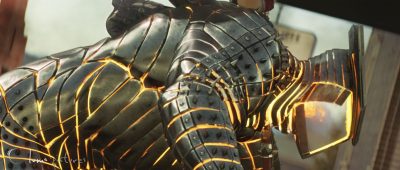 Luma also relied on a multi-layered ‘Nexus’ shader for the metallic look of Destroyer. Says Sutherland: “We’d have fine control over the reflectivity, the reflection normal and how much the scratches show up in certain areas of the model which could be adjusted in the lighting scene file without having to go back to modeling and texturing. The final shots were rendered in mental ray.”
Luma also relied on a multi-layered ‘Nexus’ shader for the metallic look of Destroyer. Says Sutherland: “We’d have fine control over the reflectivity, the reflection normal and how much the scratches show up in certain areas of the model which could be adjusted in the lighting scene file without having to go back to modeling and texturing. The final shots were rendered in mental ray.”
All of the final animation was key-framed, although artists did look to some mo-cap reference from a Xsens MVN suit worn by the director. “It was a fine line for The Destroyer’s movements,” says Cirelli. “How do we make it feel not like a robot, but also not so nimble that it feels like a human – it had to be something in between. He had to move fast and he’s also contorting all the time. It basically needed to feel like a heavy suit of armor.”
For one scene when The Destroyer is speared by Sif from above, the creature at first appears to slump but then transforms its body to turn around and return to the offensive. Luma relied here on a third rig which separated out the abdomen and the legs. “The slats are not only rotating but there’s also a little bit of hidden give in them, so they still feel rigid,” explains Pimentel. “It required different types of deformers and a custom lattice tool to deform within a geometric space. We defined some low resolution guidelines of CG geometry for how the slats should deform and then we could make modifications on the low res version of that rig, and the hi res one would stay within those confines.”
The Destroyer’s true power is seen when he launches his fire beam on the town and its inhabitants. The weapon is seemingly conjured up from inside his structure, with that part of the effect realized using fluid dynamics in Houdini. “We took a fairly low res version of the model that was completely enclosed and had no spaces between the slats,” says Cirelli. “Then we ran a simulation inside of that, combining the sim with different fluid renders and a particle render to get hot embers that churn around when the fire kicks up. All that had to start in certain areas, and then grows, so it had to be art directed.”
“We created an ignition grid,” continues Cirelli, “that allowed us to paint in where we wanted the fluid to start and where we needed it most and painted in fuel for the simulations. The sims would drive any additional particles that we had. We also decided to open up a few slats and you could see a little bit of fire wisp out here and there, especially when he gets stabbed by the sword.”
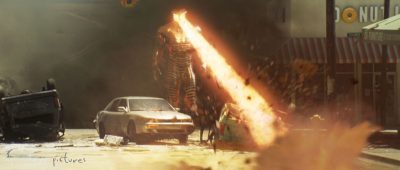 The resulting beam had its origins in terms of look development from rocket footage. “Wes had gathered a lot of reference and he pointed us towards JPL and rockets,” says Sutherland. “They wanted a high velocity look. They didn’t want dragon’s breath – they wanted this hybrid where there’s this intense energy coming out that had the coloration of fire and little edges of fire. The final beam was a fluid sim using FumeFX along with geometry. We set up a simple cylinder and created a lot of textures on top of that and then emitted fluids off of that cylinder into a fluid grid. There’s also a particle layer to add the hot embers.”
The resulting beam had its origins in terms of look development from rocket footage. “Wes had gathered a lot of reference and he pointed us towards JPL and rockets,” says Sutherland. “They wanted a high velocity look. They didn’t want dragon’s breath – they wanted this hybrid where there’s this intense energy coming out that had the coloration of fire and little edges of fire. The final beam was a fluid sim using FumeFX along with geometry. We set up a simple cylinder and created a lot of textures on top of that and then emitted fluids off of that cylinder into a fluid grid. There’s also a particle layer to add the hot embers.”
Luma also had to integrate the beam with practical explosions shot on set, occasionally introducing additional CG elements to make the shots work in stereo. “You can’t ‘cheat’ like you can in 2D,” notes Cirelli. “When the beam is blowing something up and there’s practical fire or explosions, you need to augment that with CG fire or flames otherwise it doesn’t feel like you have beams cutting into a volume. So we created a library of smoke elements and explosions that matched what was done on set, which were great reference.” Luma composited the The Destroyer shots in Nuke, using custom tools to push passes directly into their own Nuke viewer.
The Destroyer’s brief, but just as devastating, appearance on Asgard to thwart the attempts of the Frost Giants, features a unique gate, also an effect completed by Luma. “That was a grid of particles with geometry instanced on each particle,” explains Payam Shohadai, Executive Visual Effects Supervisor. “Our effects artist created maps with values from zero to one and would draw white where he wanted the gate to remain, and black where he wanted it to shrink down, and fed that into the animation of the geometry for each particle. We could easily paint how we wanted the gate to open and close. All the volume and mist you see behind him is a simulation and volumetric light coming through the volume.”
Stereo – finding the primary interest of convergence
Thor was a post-conversion film, but Sewell and Marvel took a unique approach to the stereo. They began by asking a number of conversion facilities to perform a test on existing Iron Man footage. Stereo D was then awarded the work based on its test conversion. For Sewell, allowing for conversion in post was preferable to shooting with a stereo rig.
“I think post conversion lets you create a depth continuity in your film that you can’t if you shoot natively in 3D,” he says. “We took the time to create a depth script which gives you a very comfortable viewing experience. You can even animate the depth during the shot. You can also use it for effect to let you go to a deep shot if you want to.”
In terms of workflow, there were essentially four types of conversion for the film:
Type 1: Pure conversion – this was where the original photography did not require any visual effects, and so the material would be sent to Stereo D. Some completed visual effects shots were converted this way as well as if they were original photography.
Type 2: No conversion necessary – completely CGI shots would be finaled in 2D and then reproduced in 3D and delivered by the effects vendor.
Type 3: Hybrid – this involved working with 3D elements inside the shot. It would be finaled in 2D and then all the elements pulled apart and delivered to Stereo D. For example, a character such as Destroyer could be delivered with a z-depth map. Stereo D completes the final comp.
Type 4: Additional elements – here, the plates are converted and then sent back to the vendor to add in final volumetrics or creatures.
Sewell, Stereo D and the effects vendors followed a philosophy that they called the ‘primary interest of convergence’ – using the stereo to help focus the on main thing you needed to see on the screen. “We’re doing floating windows and bending of that space in ways that are really cool,” says Sewell. “But we can also compress the foreground a little bit so that it’s still comfortable to the eye. You’re not looking at someone deeper than the diorama just to have a conversation. They’re right there with you.”
In the end, Thor’s pitch as a classical drama, but with significant visual effects and stereo enhancement, was certainly something that maintained Wesley Sewell’s interest in the show, especially when director Kenneth Branagh came on board. “I was there when they were considering who the director should be and the moment they said they were thinking of Kenneth Branagh, I just said ‘Yes!’. It all made sense with his classical drama experience and his approach to the intelligence of his characters, and Shakespearean background. I mean, this is a guy who shot Hamlet in 70mm – that’s not someone who has dabbled in film-making, that’s someone who embraces the medium.”

Pingback: The 15 Biggest Marvel Movie Plot Holes That Make No Sense – For The Love Of Buzz
Pingback: The 15 Biggest Marvel Movie Plot Holes That Make No Sense – FrentyFeed
Pingback: The 15 Biggest Marvel Movie Plot Holes That Make No Sense – Googply